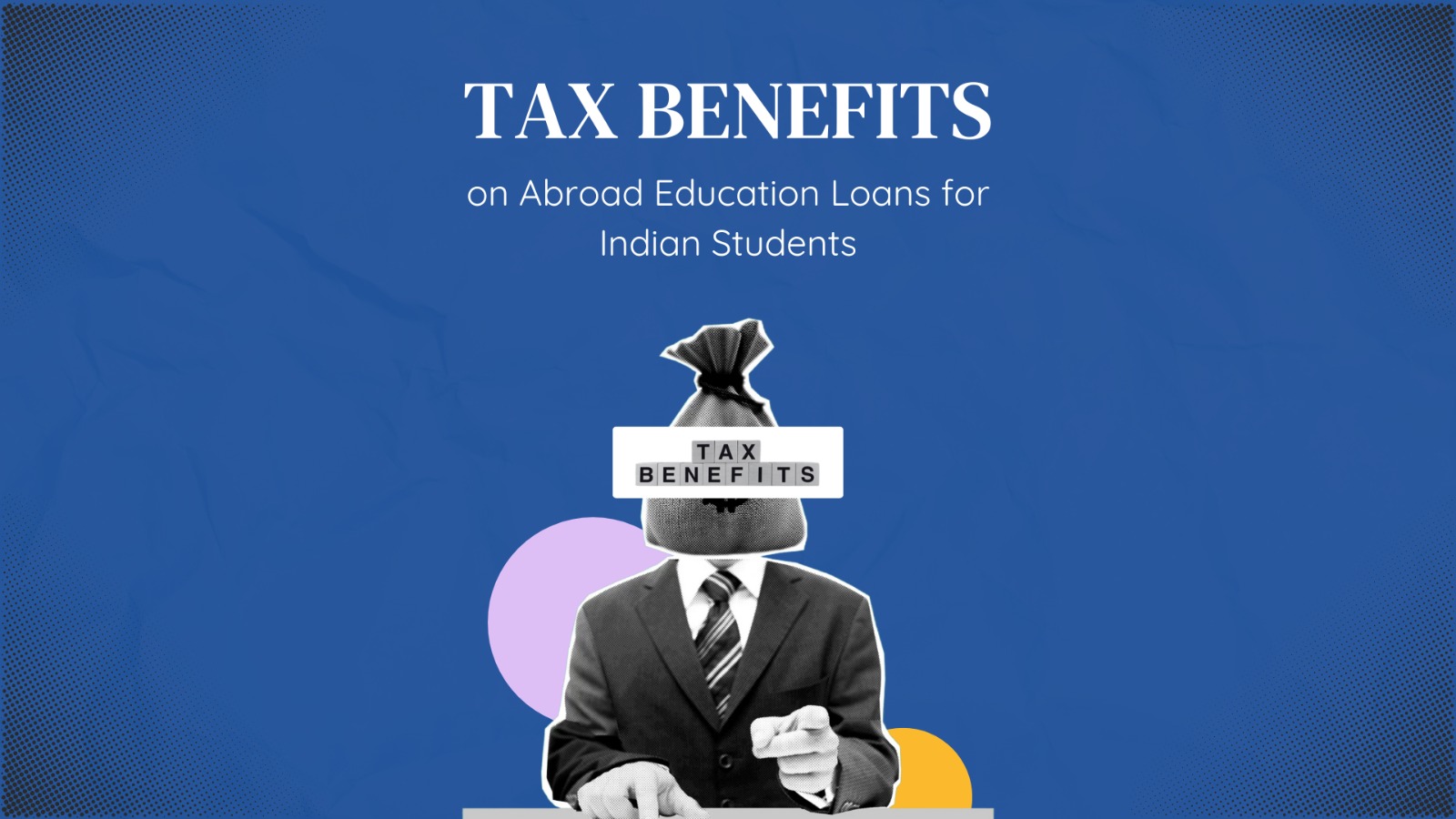Tax Benefits on Abroad Education Loans for Indian Students

Synopsis: Section 80E of the Income Tax Act, 1961 gives a deduction on interest paid for education loans for higher studies in India or abroad, for up to eight years. The deduction applies only to the interest, with no cap. The loan must be from a recognized institution or approved charity, and can be claimed by the borrower or family member. This also provides significant tax benefits on abroad education loans. Pursuing higher education abroad is a dream for many Indian students. However, it comes with substantial costs that can strain family finances. Education loans often serve as a lifeline to fund tuition, accommodation, and other expenses. Did you know these loans also offer tax benefits under the Indian Income Tax Act? In this guide, we explore everything you need to know about tax benefits on education loans for Indian students planning to study abroad. What is Section 80E Income Tax Deduction? Section 80E of the Income Tax Act allows individuals to claim a deduction on the interest paid on education loans. This benefit applies to loans taken for higher education in India or abroad, making it a valuable relief for students and their families managing hefty expenses. The deduction is solely on the interest component, not the principal amount. This relief can significantly ease the financial strain, especially for families supporting students in dollar-dominated countries. Tax Exemption Limits One of the most appealing aspects of Section 80E is that there is no upper limit on the amount of interest you can claim. Whether the interest paid is INR 1 lakh or INR 10 lakh annually, you can deduct the entire amount from your taxable income. This can significantly reduce your tax burden, making it easier to manage overall expenses. Education Loans Tax Benefits Tax benefits under Section 80E apply to loans taken for higher education, including tuition fees, accommodation, and other expenses, for courses pursued in India or abroad. However, only loans from recognised financial institutions or approved charitable organisations are eligible. If you’re unsure whether your loan qualifies, check with your lender or a financial advisor. Who Can Claim Tax Benefits? The deduction can be claimed by the individual who has taken the loan and is repaying it. Typically, it is the student or their parent, spouse, or legal guardian who qualifies, provided they are the ones paying the interest. This flexibility allows multiple family members to contribute to the student’s education without missing out on tax benefits. Which Financial Institutions Offer Tax Benefits? Only loans from approved banks, financial institutions, or charitable trusts are eligible for tax deductions. Popular institutions in India like SBI, HDFC Bank, ICICI Bank, and NBFCs like Credila offer education loans that qualify under Section 80E. Ensure you check the loan terms to confirm eligibility for tax benefits. Recognised charitable trusts also provide loans, so exploring these options can broaden your financial support avenues. Period of Section 80E Deduction The tax deduction is available for a maximum of 8 consecutive years, starting from the financial year in which the loan repayment begins. If the loan tenure exceeds 8 years, deductions cannot be claimed beyond this period, even if interest payments continue. This timeline makes it essential to plan your repayment schedule strategically. Maximum Amount that can be Claimed under Section 80E Income Tax There is no maximum cap on the deduction amount. However, the benefit is limited to the interest component of the loan repayment. This makes it crucial to keep accurate records of interest payments, as these form the basis for your tax deduction claims. Mode of Deduction The deduction is applied directly to your taxable income. It reduces the taxable portion, thereby decreasing the overall tax payable. This deduction does not fall under the purview of Section 80C, so it does not affect other savings and exemptions you may claim. By separating these benefits, you can maximise your overall tax savings. When to Claim Income Tax Benefits on Education Loans under Section 80E? You can claim the deduction as soon as you begin repayment of the education loan, which usually starts after the moratorium period (6-12 months post-course completion). The deduction can only be claimed during the assessment year corresponding to the financial year of repayment. Planning early and understanding the repayment structure with your lender can help you optimise these benefits. Eligibility Criteria How to Claim Tax Benefits? To make the most of the tax benefit on your education loan under Section 80E of the Income Tax Act, 1961, here’s a simple guide to follow: Should You Repay Your Loan Early? While repaying a loan early might seem advantageous, consider the following: FAQs Is the entire loan amount eligible for tax benefits? No, only the interest paid on the loan qualifies for deductions under Section 80E. Can I claim tax benefits if I’m studying abroad? Yes, Section 80E covers loans for higher education abroad as long as it’s from an approved financial institution. Can a co-borrower claim the deduction? Yes, the co-borrower (parent, spouse, or guardian) repaying the loan can claim the benefit. What happens if I repay my loan in less than 8 years? You can claim the deduction only for the years in which repayment occurs, up to a maximum of 8 years. Are NBFC loans eligible for tax benefits? Yes, if the NBFC is recognised under Section 80E, like HDFC Credila or Auxilo. Can I claim deductions for a loan taken for a diploma course? Yes, as long as the diploma is recognised as higher education by relevant authorities. Is the moratorium period included in the 8-year deduction window? No, the deduction period begins only when you start repayment, after the moratorium. Can I claim Section 80E benefits along with Section 80C? Yes, Section 80E is separate from Section 80C, allowing you to claim both benefits simultaneously.
RBI Guidelines for Study Abroad Loans 2025

Synopsis: The report outlines the process for resolving complaints related to education loans in India, noting that if issues remain unresolved after a month, they can be escalated to the RBI’s Ombudsman. It also discusses tax deductions available under Section 80E and recommends that students check the most recent Model Education Loan Scheme and their respective bank policies, as RBI guidelines for Study Abroad. Embarking on an educational journey abroad is a dream for many Indian students. To turn this dream into reality, understanding the financial avenues available is crucial. The Reserve Bank of India (RBI) guidelines for study abroad loans streamline education loans for overseas studies, ensuring that students receive the necessary financial support under fair and transparent terms. Let’s delve into these guidelines to provide a clear roadmap for aspiring scholars. Eligibility Criteria To qualify for an education loan under RBI guidelines, students must: Loan Amount and Margin Requirements The RBI has set specific limits and margin requirements for education loans: Note: Scholarships and assistantships can be included in the margin, reducing the student’s financial burden. Security and Collateral Requirements Security requirements vary based on the loan amount: These measures ensure the loan is adequately secured, protecting both the lender and the borrower. Interest Rates The RBI guidelines for study abroad loans has deregulated interest rates on advances, including education loans. Consequently, banks determine their interest rates with the approval of their respective Board of Directors, subject to regulatory guidelines. It’s advisable for students to compare rates across banks to secure the most favourable terms. Repayment Terms Repayment terms are designed to provide flexibility: Early repayment options are often available, and some banks may offer concessions for timely repayments. Service Area Approach Banks are advised not to reject education loan applications based on the applicant’s place of residence. This ensures that students across the country have equitable access to financial assistance, regardless of their geographic location. Grievance Redressal Mechanism In case of grievances related to education loans: Tax Benefits Under Section 80E of the Income Tax Act, borrowers can avail tax deductions on the interest paid on education loans for up to 8 years. This benefit is available to both students and co-borrowers, easing the financial burden during the repayment period. Recent Updates The RBI guidelines for study abroad loans are periodically updated to reflect changing economic conditions and educational trends. As of 2025, students are advised to consult the latest Model Education Loan Scheme (MELS) and individual bank policies for the most current information. Embarking on higher education abroad is a significant milestone. Understanding the RBI’s guidelines for study abroad loans empowers students to make informed financial decisions, ensuring a smoother journey towards achieving their academic and career aspirations. FAQs Can I avail an education loan without collateral? Yes, for loan amounts up to ₹4 lakh, no collateral is required. For amounts between ₹4 lakh and ₹7.5 lakh, a third-party guarantee is needed. Loans exceeding ₹7.5 lakh require tangible collateral security. Are there any processing fees for education loans? Generally, banks do not charge processing or upfront fees for education loans. However, it’s advisable to confirm with the specific bank. What expenses are covered under the education loan? Education loans typically cover tuition fees, examination and library fees, travel expenses, purchase of books and equipment, and other related costs necessary for the course. Can I start repaying the loan while still studying? While the repayment period generally begins after the moratorium period, some banks offer the option to start interest payments during the study period, which can reduce the overall loan burden. Is there a penalty for early repayment of the education loan? Many banks do not charge a prepayment penalty for education loans, encouraging borrowers to repay earlier if possible. However, it’s essential to verify this with your chosen bank.
Documents Required for Abroad Education Loans

Synopsis: Know more about the documents required for applying for an education loan to study abroad. From basic documents like a valid passport, ID proof to academic documents like standardised test scores, and details of any scholarships to your co-applicant’s bank statements, income tax returns to additional documents for a secured education loan, here’s a detailed list of documents required. If you’re about to start your study abroad journey, we know the amount of excitement you have for the most transformative experience of your life. From the thrill of exploring new cultures to gaining a global perspective, international education provides endless opportunities. But we know the mere thought of financing your dream education abroad might pull you back. Introducing: education loans! The financial gap is no more a thing to tackle with the amazing options of financing provided by Indian and international lenders. While navigating your loan application, one daunting task that you wish you could skip is completing the documentation. Does the never-ending list of documents feel like a hurdle in your study abroad dream? Yes, we feel you! Don’t frown, rockstar! At Lorien Finance, we’re here to help you every step of the way. We’ve prepared a comprehensive guide to assist you with all the paperwork required in the process of securing an education loan for your studies abroad. From the necessary academic transcripts to the nitty-gritty financial proofs, to your cosigner’s details, we’ll bifurcate it all so you can complete your loan application confidently. Documents Required for Applying a Study Abroad Loan To secure an education loan for studying abroad seamlessly, you would require various documents to be submitted to the lenders. These documents can be categorised into various categories like academic documents, KYC documents and financial documents. Understanding the document requirements of the lenders is a crucial step for a student in their study abroad journey. Documents required from the applicant Documents required from the co-applicant Salaried Co-Applicant Self-employed Co-Applicant Additional Documents Required for a Secured Education Loan for Abroad Documents Required after Sanctioning the Study Abroad Loan To formalise the loan agreement and facilitate the disbursal of your loan, the lender provides you with some documents after your loan is sanctioned. These documents include: Documents Required for Disbursement of Study Abroad Loans After your study abroad loan has been disbursed, you will be required to share certain documents with your lender to ensure compliance with the loan agreement. These documents include: FAQs Can I apply for an education loan without a cosigner? Most lenders in India require a cosigner/co-applicant for abroad education loans, especially for higher amounts or unsecured loans. The co-applicant provides additional assurance of repayment. Can I secure an education loan if my co-applicant has a low credit score? A low credit score may affect loan approval and interest rates. It’s advisable to improve the credit score before applying or consider adding an additional co-applicant with a better credit score. At Lorien Finance, we’re here to help fund your abroad education in every way possible. Are there any tax benefits on education loan repayments? Section 80E of the Income Tax Act allows you to deduct the interest paid on education loans from taxable income, reducing your tax liability. How does the moratorium period work for education loans? The moratorium period is a grace period during which you’re not required to repay your loan, typically lasting until the completion of your course plus an additional 6-12 months. Interest may accrue during this period. Can I prepay my education loan without penalties? Many lenders allow prepayment of education loans without penalties, but it’s essential to check the specific terms and conditions of your loan agreement. Lorien Finance ensures you know all these factors while securing your abroad education loan.
Trudeau resigns as Canada PM: Impact on Indian students

Synopsis: During Trudeau’s tenure, Canada became a top destination for Indian students due to simplified visa processes, post-graduation work opportunities, and a welcoming society. However, even before Trudeau’s resignation, the Canadian government started imposing stricter regulations, including reducing international student permits, requiring higher family incomes, and limiting student work hours. With the potential change in leadership to Conservative Pierre Poilievre, Indian students are concerned about further tightening of immigration policies, increased competition for part-time and post-graduation work, and overall uncertainty about their prospects in Canada. While Canada remains a top choice, students are advised to stay updated on policy changes, explore education financing options, and consider guidance from immigration consultants. Despite the shifts, Canada’s core values of diversity and opportunities for international students are expected to continue, though the path may require more planning and effort. Indians have always considered Canada a land of dreams, offering world-class education and opportunities to shape a bright, global future. Over the years, the country has become a second home for many, thanks to the policies that helped international students to thrive. But with Justin Trudeau stepping down as Prime Minister on January 6 2025, there’s a growing sense of uncertainty: Will Canada be as welcoming for Indian students as before? Let’s dive into what this political shift means for students in Canada and those dreaming of getting there. Why Indian Students Chose Canada During Trudeau’s Era? For Indian students, Justin Trudeau’s time as PM felt like a golden age. The number of Indian students studying in Canada soared from 31,920 in 2015 to a staggering 278,250 in 2023. This was contributed by the seamless policies, including: For Indians, Canada has never been just an education destination—it was considered a land of possibilities where they could thrive and create a better future. The Shifts That Started Before Trudeau Left Even before Trudeau announced his resignation, the cracks in this perfect picture were beginning to show. In 2024, the Canadian government started imposing stricter regulations to tackle housing shortages and stretched public services. Key changes included: These changes sent shockwaves through the entire international student community. Suddenly, what seemed like a second home started looking outré. What Pierre Poilievre Could Bring to the Table? With Trudeau stepping down, Conservative leader Pierre Poilievre has emerged as a potential successor. His views on immigration have raised eyebrows, especially among international students. In a recent statement, Poilievre linked international students to Canada’s housing crisis and job market challenges, saying: “Housing is expensive, jobs are scarce, and public services are stretched thin. Adding more temporary workers and international students without addressing these issues will only make life harder for Canadians.” If Poilievre takes over Canada, here’s what might change: For Indian students, this could mean more hurdles in their race to a global future—whether they’re already in Canada or still planning their journey. How Indian Students Are Feeling Right Now? For those already in Canada, the mood is mixed. Students are concerned about the upcoming restrictions on work opportunities, which could enhance their financial hardships. Others worry that changes in post-graduation work permits could make it harder to secure a permanent residency (PR). For students back in India, the dream of studying in Canada now feels like an even distant cry. With tightened regulations and ever-increasing costs, Indians are reconsidering their options or exploring alternatives like the UK, Australia, or Germany. Tips to Navigate These Changes Change can be challenging, but preparation makes all the difference. Here are some practical steps for students: The Bigger Picture: Canada Still Values Diversity Despite political shifts, Canada stands firm on it’s core values. It’s still a country that recognises the contributions of international students—economically, academically, and culturally. Yes, policies may evolve to prioritise serious students and align with Canada’s infrastructure needs, but the essence of Canada as a land of opportunities remains. Indian students have played a huge role in shaping Canada’s present, and there’s every reason to believe they’ll continue to shape its future. Final Thoughts Political shifts are inevitable, but they’re also an opportunity to reflect, and rise above challenges. For Indians, studying in Canada may now require a bit more planning and effort, but the rewards remain worth it. So, while Trudeau’s resignation marks a turning point, it doesn’t have to be the end of your dream. With resilience and the right support, the dream of studying in Canada can still become a reality. At Lorien Finance, we’re here to support you throughout your journey. Whether it’s financing your education or navigating the uncertainties, we’re committed to helping you achieve your dreams.
CPT vs OPT: What’s the difference?

Excerpt The blog provides an overview of Curricular Practical Training (CPT) and Optional Practical Training (OPT), which are work authorization options for international students studying in the United States. It explains the key differences between CPT and OPT, including their eligibility criteria, types, and application processes. The document also covers topics such as the STEM OPT extension, Cap-Gap extension, and handling job-related scenarios while on OPT. Overall, the document aims to guide international students on navigating these work authorization options to gain relevant work experience during and after their studies. Are you planning to study in the US or have arrived in the States to pursue your higher education? Congratulations on your exciting journey ahead! However, we understand you’ve started searching for ways to gain relevant work experience while studying. Fret not, as we introduce you to the two superstars of student work authorisation – CPT and OPT. Think of CPT as your internship wingman and OPT as your career launchpad. So if you plan to know how you can gain work experience in the best possible way in the US, don’t worry, we will explain everything in a snap! Understanding CPT and OPT Curricular Practical Training (CPT) permits students enrolled in F-1 status to undertake work directly related to their curriculum, and this may include practices such as internships, cooperative education or any other practical training offered by a sponsoring employer in association with the students’ college/university. With no restriction of working 20 hours/week, students can even work full time while training. Note: In order to qualify for CPT, you must be an F-1 visa holder and have completed a full year studying at a Student and Exchange Visitor Program (SEVP) certified university. Optional Practical Training (OPT) provides international students with the opportunity to work in the US for up to 12 months. STEM graduates can avail a 24-month extension on their OPT. Note: Students at each level in their academic journey can apply for 12 months of OPT. Types of OPT Pre-completion OPT Students studying in any US institution certified by the US Immigration and Customs Enforcement (ICE) and the Student and Exchange Visitor Program (SEVP), are eligible to avail the pre-completion OPT. However, they must complete one full year studying in any institution in the US. Students authorised to avail the pre-completion OPT can work up to 20 hours a week while the school is in session or work full-time when the school is not in session. If your employer wishes to extend your employment, you will need to switch from an F-1 visa to an H-1B visa. Note: The duration availed for pre-completion OPT will be deducted from the available period of post-completion OPT. Post-completion OPT Students may choose to apply for post-completion OPT after successfully completing their program. All students are required to work for at least 20 hours a week or full-time, if authorised. Note: Students in STEM fields can apply for a 24-month extension on their post-completion OTP. STEM OPT Extension If you are studying at a US institution to secure a degree in courses like Science, Technology, Engineering, and Math (STEM), you are eligible to opt for a 24 months extension for your OPT. To avail the extension, you must fulfil the following eligibility criteria: Cap-Gap Extension A Cap-Gap extension helps you extend the tenure between the end of your F-1 visa and the start of your H-1B status. Key Differences between CPT and OPT To highlight the major difference between CPT and OPT, it’s essential for students to understand when they are eligible for either of the trainings. To put it in simple terms, CPT needs to be completed before the completion of their course, while OPT can be completed before or after their graduation. Let’s have a look at some of the other aspects to understand how CPT and OPT differ! CPT OPT Purpose To permit F-1 students to gain practical experience before graduating To permit F-1 students to gain practical experience after graduating Authorised by Requires permission from ISS (International Social Service) and the academic department Requires permission from USCIS (US government) Employment Duration Up to 12 months 12 months and can be extended up to 24 months Application Fee No application fee required An application fee of $410 should be paid to the USCIS Employment Type Part-time during school (20 hours per week) Full-time during break (40 hours per week) Full-time post graduation General Eligibility For CPT Training must relate to the student’s field of study The CPT should be authorised by the DSO in SEVIS The training should start before the end date of the program The training opportunity must be secured before authorising CPT For OPT Training must relate to the student’s field of study The student’s DSO must recommend OPT in SEVIS The student must not secure training before the DSO recommends OPT Documents Required for CPT and OPT Documents Required for CPT Documents Required for OPT CPT online workshop completion certificate 2 passport-size photographs Academic recommendation form I-765 (original) Copy of present I-20 Present passport’s copy In-depth description of training by your employer A printout of I-94 Print out of electronic form I-94 Copy of OPT recommendation and I-20 Copy of all the earlier issued I-20s Any earlier issued EAD cards’ copies F-1 visa stamp’s copy on passport How to Apply for CPT? To apply for your CPT, the steps would vary as per your university. However, some of the basic steps for the application include: Connect with the DSO at your university to know about the CPT options available at your institution, the requirements and the sponsoring employers. Secure an offer letter from your employer with all the necessary details. Ensure applying timely to the CPT program through your university with all the required documents. Once your CPT application is approved, you will have to sign a formal document with the training start and end date and safely keep a copy with you. Connect with your employer and share the relevant CPT
Rupee Weakens Past 85/USD: Impact on Indian Students Planning to Study Abroad

Dreaming of studying abroad but worried about rising costs as the rupee weakens? Discover how the depreciation past 85/USD impacts tuition, living expenses, and loan repayments—and more importantly, learn strategies to turn these challenges into opportunities. You’ve been planning to study abroad, chasing your dreams of attending a world-class university. But with the Indian rupee recently breaching the 85/USD mark, the financial path may feel more confusing than ever. For many Indian students like you, this depreciation translates to higher tuition fees, steeper living expenses and tougher financial decisions. Let’s break it down and explore how you can navigate this challenge without compromising your aspirations. Impact on Tuition Fees and Living Expenses Studying in dollar-dominated countries, like the U.S., just became more expensive. If you’re budgeting for your education, here’s what the weaker rupee means for you: Effect on Education Loans If you’re planning to fund your studies with an education loan, the rupee’s depreciation means you’ll need to consider: Challenges in Daily Expenses Daily expenses can quickly add up when studying abroad. Here’s what you might face: Potential Advantages for Overseas Earners On the brighter side, if you secure a part-time job or post-graduation employment abroad (ref CPT and OPT), you can turn the weaker rupee to your advantage: Mitigation Strategies The good news is that with the right approach, you can still manage your finances effectively. Here’s how: Leverage Lorien Finance’s USD Loans Additional Strategies: Conclusion Yes, the weakening rupee brings challenges, but it doesn’t mean you have to put your dreams on hold. With rising tuition costs, higher living expenses, and increased loan repayment amounts, planning ahead becomes crucial. However, earning in stronger currencies and leveraging solutions like Lorien Finance’s USD loans can help you manage these hurdles and stay on track. Let’s make your study abroad journey extraordinary. Talk to Lorien Finance’s loan experts today to explore options tailored to your goals. Together, we’ll turn your financial challenges into opportunities and help you achieve your dreams. FAQs How does the weaker rupee affect tuition fees? Tuition fees become more expensive in rupee terms, with a $40,000 program now costing INR 34 lakhs at 85/USD compared to INR 28 lakhs earlier. How are living expenses impacted? Costs for essentials like rent, food, and transport rise significantly as the exchange rate increases. Does the depreciation affect education loans? Yes, loan amounts and repayment costs increase, adding 3-5% annually for INR loans. Are there any benefits to earning abroad during this time? Earning in stronger currencies like USD can ease loan repayments, as higher exchange rates work in your favour. How can I manage rising expenses? Opt for USD-denominated loans, apply for scholarships, work part-time, and budget carefully to offset increased costs. Are there alternatives to studying in the US due to high costs? Countries like Canada or Germany offer quality education with comparatively lower tuition and living expenses. How can Lorien Finance help with these challenges? Lorien Finance offers USD loans, no-collateral options, and personalised financial planning to help manage study abroad expenses. What part-time work opportunities can help mitigate costs? Countries like the US allow students to work up to 20 hours weekly, providing additional financial support. Can I secure financial aid to reduce tuition costs? Yes, applying for scholarships or need-based aid can significantly lower your expenses. Is it still worth pursuing education abroad despite the weaker rupee? Yes, with proper planning, strategies like earning abroad and USD loans can make studying abroad financially viable.
Study in Canada: A Complete Guide for Indian Students

Why Choose Canada as Your Study Abroad Destination? Dreaming of studying in Canada in 2025? For Indian students, Canada isn’t just a destination-it’s the desh ki dhadkan of higher education. You’re not alone! Known for its top-tier education system, multicultural society, global recognition, and welcoming environment, Canada is one of the most popular destinations for Indian students. Canada isn’t just about maple syrup and breath-taking landscapes. It’s a place where dreams come true, Bollywood-style! Picture yourself saying, “Mera sapna sach ho gaya!” after receiving a degree from a globally ranked university. Canada offers: Canada’s Education System Canada’s education system is inclusive, student cantered, and geared toward producing globally competitive graduates. It integrates practical skills, critical thinking, and academic excellence, ensuring students are well-prepared for future challenges. With over 200 institutions, students have access to innovative research labs, practical learning, and career-focused curricula. Education in Canada is governed by provincial and territorial governments, not the federal government. Each province has its own Ministry or Department of Education, responsible for setting curricula, policies, and funding. For example: The Council of Ministers of Education, Canada (CMEC) serves as a collaborative body that ensures consistency and sharing of best practices across provinces and territories. Popular Student-Friendly Cities in Canada The QS World University Rankings 2025 ranked Montreal, Vancouver, Toronto, Ottawa and other Canadian cities as one of the best student cities in the world. Let’s learn more about these cities and what makes them unique. Top Universities to Study in Canada in 2025 Home to numerous prestigious educational institutions, Canada is committed to academic excellence, research innovation, and industry-focused education. Let’s have a look at the top 5 universities in Canada as per the QS World Ranking 2025: University QS Rank City University of Toronto 25 Toronto McGill University 29 Montreal University of British Columbia 38 Vancouver University of Alberta 96 Edmonton University of Waterloo 115 Waterloo Top Courses to Pursue in Canada in 2025 Canada is attracting numerous international students in 2025 in high-demanding fields like: Intakes in Canadian Universities Cost of Studying in Canada 2025 If you plan to pursue courses like arts, humanities and education in Canada, you’ll find it cheaper as compared to pursuing courses like medicine, engineering, business and management. Moreover, the costs would also differ depending on the program you choose. Expense In CAD Tuition fee CAD 36,123 (approx) Visa fee CAD 150 Travel fare CAD 1300 Cost of Living in Canada 2025 Here’s a list of the approximate breakdown of monthly expenses for international students: Expenses In CAD Accommodation CAD 500-2500 per month Food and Groceries CAD 200-400 per month Transportation CAD 80-150 per month Healthcare and Insurance CAD 600-800 per year Eligibility Criteria for Studying in Canada If you plan to pursue your higher education in Canada, you must be at least 18 years of age and have a high school diploma, bachelor’s degree, or master’s degree in a related field. You must meet the test score requirements for the exam you choose to take. For example, you may need a score of at least 6.0 on the IELTS, 90 on the TOEFL, or 300+ on the GRE. You need to prove sufficient funds to cover tuition, living expenses, and return transportation, with CAD 20,635 required in your bank account. Enrollment at a Designated Learning Institution (DLI) is necessary, and you must show intent to leave Canada once your study permit expires. How to Apply for an Education Loan for Studying in Canada? Securing an education loan to study in Canada can be a time-consuming process as you will compare various lenders to find the most suitable loan for you. It is also recommended that you start the loan process for studying in Canada at least 3-4 months before your enrolment day to ensure smooth and timely completion. At Lorien Finance, we ensure you don’t have to go through this daunting and time-consuming process, thus, we do all the hard work for you. On getting in touch with you, our loan counsellors understand all your needs related to securing a study abroad loan for Canada in your dream university and help you compare the interest rates among 15 international and domestic banks and NBFCs. They negotiate with these lenders on your behalf so that you fulfil your study-abroad dream cost-effectively. Once you find the most suitable lender per your needs, the loan counsellor will help you proceed with the application process. After submitting all required information and necessary documents, your application will be logged in with the lender, who after carefully scrutinising it, will approve or reject it. Lorien’s loan counsellors help you throughout the way to minimise any chances of loan rejection. Once the loan is sanctioned, you decide your loan disbursement date and finalise your loan. We aim to ensure you have a smooth loan application process without any hassle so that your focus remains on your education abroad. How to Apply for a Student Visa for Studying in Canada? With some of the world’s top universities offering high-quality education, study in Canada for international students from all parts of the world are attracted to the country. Studying in Canada for Indian students to pursue higher education, require a study permit. To know everything you’d need for a study permit for Canada, continue reading: Since you’re planning to pursue your bachelor’s or master’s in Canada, you would require a D study visa or a long-term study visa (meant for a stay of more than 3 months). It is recommended to apply for a long-term study visa up to 3 months before your date of travel to Canada from your home country. Documents Required for Applying for a Canadian Student Visa Post-Study Work Visa in Canada Once you complete your studies in Canada, you might want to stay a little longer and consider taking up career opportunities to gain work experience in your related field of study as part of your Canadian post-study work visa plan. This will only strengthen your CV and add
Study in New Zealand: A Complete Guide for Indian Students

Why Choose New Zealand as Your Study Abroad Destination? Rapidly emerging as one of the top study abroad destinations for Indians and other international students, New Zealand ranks as the 6th safest country in the world as per Berkshire Hathaway’s 2025 report. The country has a perfect mix of renowned universities, a vibrant culture and a dynamic economy, making it an ideal destination for Indian students seeking quality education. Not to miss, the breath taking landscapes of New Zealand that add to students’ experience in the country. Ranked as the 4th most peaceful country in the world as per the Global Peace Index 2024, New Zealand offers a welcoming and safe environment to all international visitors, ensuring a high quality of life. The beautiful country even offers a Post-Study Work Visa for up to three years, allowing international students to seek employment and gain work experience post-graduation. Moreover, around 95% of graduates from New Zealand find employment within six months of graduating. New Zealand’s Education System New Zealand’s education providers follow the New Zealand Qualifications Framework (NZQF) to acknowledge the level and quality of qualifications offered. The NZQF has 10 levels, 7 to 10 covering degrees, graduate and postgraduate qualifications. New Zealand has 8 state-funded universities, 16 Institutes of Technology and Polytechnics (ITPs) which have been unified into the New Zealand Institute of Skills and Technology (NZIST), and about 550 Private Training Establishments (PTEs), which include English language schools. Popular Student-Friendly Cities in New Zealand With numerous cities boasting world-class universities and rich culture, study in New Zealand for international students is a top choice for international students. As per the QS Best Student Cities 2025, here’s a list of some of the best cities in New Zealand: City Rank Student MixProportion of International Students Employer ActivityYouth Employment Activity Auckland 24 90.4 68.7 Christchurch 79 71.8 40.9 Top Universities to Study in New Zealand 2025 New Zealand’s prestigious universities focus on academic excellence, research innovation, and providing hands-on experience. Let’s have a look at the top 5 universities in New Zealand as per the QS World Ranking 2025: University Rank City The University of Auckland 65 Auckland University of Otago 214 Dunedin University of Waikato 235 Hamilton Massey University 239 Palmerston North Victoria University ofWellington 244 Wellington Top Courses to Pursue in New Zealand in 2025 With some of the most diverse degrees to pursue, 2025 will see an increasing number of students opt for the following programs in New Zealand: Intakes in New Zealand Universities Now that you’ve planned to study in New Zealand, you must be informed about the intakes universities offer.New Zealand universities offer two intakes: the first one starts in January and the other starts in July. There’s also a rolling intake where universities accept applications throughout the year. New Zealand universities receive a large number of applications in the July intake. Most international students opt for the July intake as it allows them to choose from a wide range of courses and universities. To help you better, here’s a timeline of how and when to plan your education abroad in New Zealand: Timeline for July 2026 Intake Events August-December 2025 Research and shortlist your course and university December 2025-February 2026 Take the required proficiency exams February-March 2026 Compile your documents and apply to shortlisted universities March-April 2026 Receive Offer Letter April-June 2026 Apply for your student visa July 2026 Plan your travel Study in New Zealand Cost in 2025 The cost of education in New Zealand depends on the program and university you choose to study in. Pursuing courses like humanities, education, and arts is comparatively more affordable than pursuing programs in medicine and engineering fields. Let’s have a look at the costs involved in pursuing various programs: Program Tuition Fees (annual) Diploma or Certificate NZD 23,376 – NZD 47,752 English Language NZD 350 (per week) Bachelor’s NZD 20,000 – NZD 40,000 Master’s NZD 20,000 – NZD 45,000 Doctoral NZD 6,500 – NZD 7,500 Cost of Living in New Zealand 2025 Living in New Zealand as an international student, your expenses would rely on aspects like which city your university is in, how you commute to your university, and the type of accommodation you opt for. Here’s a classification of expenses for living in Germany: Expenses In NZD Accommodation On campus NZD 215 to NZD 555 per weekOff campus NZD 120 to NZD 600 per week Utilities NZD 100 per month Food and groceries NZD 80 to NZD 100 per week Insurance (health & travel) NZD 350 per semester Phone bill NZD 20 per month Internet NZD 70 per month Public Transport NZD 2.5 to NZD 37 per week Scholarships Available for International Students in New Zealand With world-class education opportunities in prestigious universities, New Zealand offers numerous fully funded scholarships. Scholarships for Indian students aspiring to study in New Zealand make it the perfect choice for aspiring students seeking affordable education abroad. Let’s look at a few scholarships for Indian students planning to pursue their education in New Zealand. Eligibility Criteria for Studying in New Zealand Considered one of the most preferred study destinations in the world, New Zealand offers high education standards at world-class universities. If you plan to pursue a UG course in New Zealand, you must have a certificate of higher secondary qualification from a renowned board of education. A minimum score of 50-60% or above is required as per the universities. Universities also require language proficiency test scores such as IELTS (these scores’ requirements vary as per university). If you’re applying for a Master’s degree in New Zealand, you need to have a graduation degree in the course relevant to your field of study with a minimum score of 50-60%. GMAT or GRE grades are required for students aiming for management studies. Some universities even consider internships and work experience in the field of study. English proficiency tests such as IELTS are also required by universities (these scores’ requirements vary as per universities). How to Apply for an Education
Study in Ireland: A Complete Guide for Indian Students

Why Choose Ireland as Your Study Abroad Destination? Imagine studying in a university near a lush green field with a view of magnificent castles. No, that’s not a dream or a Yash Raj movie! It’s how studying in Ireland feels like. Offering the best of both worlds-the green countryside and a vibrant urban lifestyle, Ireland is fast becoming an ideal study destination for international students. With world-class educational institutions, a wide variety of courses, and abundant work opportunities, Ireland assures you of an astonishing experience beyond education. Moreover, the country ranks as the second safest country in the world as per the Global Peace Index 2024, so bid farewell to your dad’s apprehension or whether his child will be safe or not! Another awesome update: you can support your education in Ireland by working part-time. You’ll be allowed to work 20 hours per week during the academic session and 40 hours per week during May, June, July, August and mid-December to mid-January. Also, as a part of Ireland’s effort to attract and retain global talent, Ireland welcomes Indian students to stay back in Ireland for up to 24 months after completing their Master’s from any Irish Institution, allowing them to gain valuable work experience, and it can also lead to a work permit. Ireland’s Education System Like the UK’s education system, the Irish education system is divided into four categories, with the NFQ (National Framework of Qualifications) specifying the standards of Irish education qualifications. The third level of the Irish education system is higher education, comprising universities, colleges, and institutes of technology, most of which are funded by the Irish government. Popular Student-Friendly Cities in Ireland While the QS World University Rankings 2025 ranked Dublin as one of the best student cities in the world, Cork and Galway were picked by student reviewers as the top ones. Let’s learn more about these cities and what makes them unique. Top Universities to Study in Ireland in 2025 Home to numerous prestigious educational institutions, Ireland is committed to academic excellence, research innovation, and industry-focused education. Let’s have a look at the top 5 universities in Ireland as per the QS World Ranking 2025: University QS World Ranking 2025 City Trinity College Dublin 87 Dublin University College Dublin 126 Dublin University College Cork 273 Cork University of Galway 273 Galway Dublin City University 421 Dublin Top Courses to Pursue in Ireland in 2025 Ireland is attracting numerous international students in 2025 in high-demanding fields like: Intakes in Irish Universities Ireland has two primary admissions intakes: Spring and Fall. Spring admissions typically commence in June/ July, whereas Fall intake begins in September/ October. Some universities admit applicants in both intakes, keeping their application processes active throughout the year. Fall is notably a significant intake, with all courses available, unlike the Spring intake, which may be limited to specific courses. Study in Ireland Cost in 2025 If you plan to pursue courses like arts, humanities and education in Ireland, you’ll find it cheaper as compared to pursuing courses like medicine, engineering, business and management. Moreover, the costs would also differ depending on the program you choose. Degree Fees Bachelors Degree €9,850 to €25,500 annually Masters Degree €9,500 to €34,500 annually Doctoral Degree €9,500 to €34,500 annually Cost of Living in Ireland 2025 Living in most Irish towns like Galway, Cork, and Limerick, you would spend around 550–1,000 EUR per month depending on your budget and spending habits. However, if your university is located in large towns like Dublin, your budget can go up to 1,500–1,800 EUR per month. These costs are enough to ensure a comfortable standard of living in Ireland while you’re studying. Here’s a list of the approximate breakdown of monthly expenses for international students: Accommodation €500-2200 Utilities €150-200 Internet and phone bill €15-60 Food and groceries €250-400 Transportation €100-150 Healthcare and insurance €45-75 Available Scholarships for Study in Ireland for International Students With world-class education opportunities in prestigious universities, Ireland offers numerous fully funded scholarships. Scholarships for Indian students aspiring to study in Ireland make it the perfect choice for aspiring students seeking affordable education abroad. Let’s look at some of these scholarships for Indian students planning to pursue their education in Ireland. Eligibility Criteria for Studying in Ireland To pursue a UG course in Ireland, you must be at least 18 and have 60% in class XII. You can apply through the Central Applications Office (CAO), an online enrolment system in Ireland. For PG courses, you must complete a UG course in a relevant field. An English proficiency exam, such as IELTS, TOEFL, or PTE, is required for all courses to prove language proficiency. How to Apply for an Education Loan for Studying in Ireland? Securing an education loan to study in Ireland can be a time-consuming process as you will compare various lenders to find the most suitable loan for you. It is also recommended that you start the loan process for studying in Ireland at least 3-4 months before your enrolment day to ensure smooth and timely completion. At Lorien Finance, we handle the daunting, time-consuming process, ensuring you don’t have to do the hard work. On getting in touch with you, our loan counsellors understand all your needs related to securing a study abroad loan for Ireland in your dream university and help you compare the interest rates among 15 international and domestic banks and NBFCs. They negotiate with these lenders on your behalf so that you fulfil your study-abroad dream cost-effectively. Once you find the most suitable lender per your needs, the loan counsellor will help you proceed with the application process. After submitting all required information and necessary documents, your application will be logged in with the lender, who after carefully scrutinising it, will approve or reject it. Lorien’s loan counsellors help you throughout the way to minimise any chances of loan rejection. Once the loan is sanctioned, you decide your loan disbursement date and finalise your loan. We ensure a smooth, hassle-free loan application
Away but Not Alone: Spending Holidays Abroad as an International Student

Since we were little, the holiday season has felt like home-a warm hug from our favourite cousin, an appreciating pat from our grandfather, kids’ laughter echoing through the house, the scent of our mom’s homemade food wafting from the kitchen! As we grew up, the festivities became a time to connect and celebrate with family and friends we met after a long time because of our busy schedules. Only when we are studying in a foreign land do we realise that our first holiday season away from home feels like a bittersweet milestone. It’s the time of the year when everyone around us is celebrating Thanksgiving with pumpkin pies and turkeys and adorning Christmas trees with glistening lights and ornaments. As Indians, these festivities aren’t the ones we celebrated from our childhood, but still seeing families coming together for these unfamiliar holidays, we find ourselves missing our mom when she called us to decorate our home for Diwali, how our dads’ got us sweets, how we mischievously played with our siblings, and how our grandparents gave us money envelopes. Oh! These sweet memories! Even though Thanksgiving isn’t our festival, something about it makes us long to be back home. It’s the holiday’s essence-how the loved ones gather and share gratitude for everything-all feels too familiar. It makes us miss home, where every festival meant a celebratory union of family and tradition. As our semester abroad draws to a close, and your classmates are off to enjoy the ‘holidays’, does our social media not flood with friends from back home posting countdowns to celebrate? Meanwhile, we’re scrolling through our feeds and reminiscing how we spent the festivities and holidays with our loved ones back home. Surely feels like a gnawing pain when you’re friends call to ask about your plans for the holidays and all you answer is “I’m staying in!”. The first holiday season away from home feels heavier than we ever imagined. It’s the time when we long to be home more than ever. But there’s a beauty in this longing, with a lesson waiting to unfold. Being far away from home doesn’t mean we can’t celebrate the festivities and the holidays, but we get to celebrate them all in our own ways! As lonely as it may seem, this time helps us discover ourselves in many unique ways, enabling us to create our little moments of joy. Maybe it’s simply decorating our dorm or getting on a video call with Mom to make her oh-so-yum dal makhani and parantha. We sure can’t match her taste, but the hysterical call witnessing our laughter will make us miss home a little less. And even though our family lives miles away, the friends we made in this foreign land can feel like home! A simple act of inviting them over to share a meal and enjoy chats about how everyone celebrated the festivities back home can turn loneliness into a warm circle of loved ones. You can even go out with your friends to explore the Christmas markets near you, enjoy a holiday party, or simply enjoy hot chocolate with some pizza over a Bollywood marathon night snuggling in your bed. As we cherish new and existing traditions while embracing change, we find beauty in exploring this bittersweet journey that teaches us resilience. It’s about the joy we find when a friend invites us for Thanksgiving dinner with their family, and their pumpkin pie offers a different kind of sweetness than kaju katli but fills our hearts with nothing but love. So, if we feel lonely this holiday season, let’s stay strong knowing we’re not alone. Numerous other students, away from home, are finding ways to celebrate, connect, and feel at home in different parts of the world. And yes, it’s okay to miss home-it’s proof of the love waiting for us on the other side of this journey. It means we belong somewhere. But we also need to understand that we’re building something here-new memories, new friends, a career, and a stronger version of ourselves who can make our loved ones swell with pride. Remember, home is never as far as it feels. We carry it with us in every call, every shared story, and every moment we choose to connect over isolation. And when we’re finally back home, those hugs will be tighter, those moments richer, because we’ve lived and grown through this. Lorien Finance wishes you an amazing Thanksgiving, a baller Black Friday and joyous holidays ahead!
